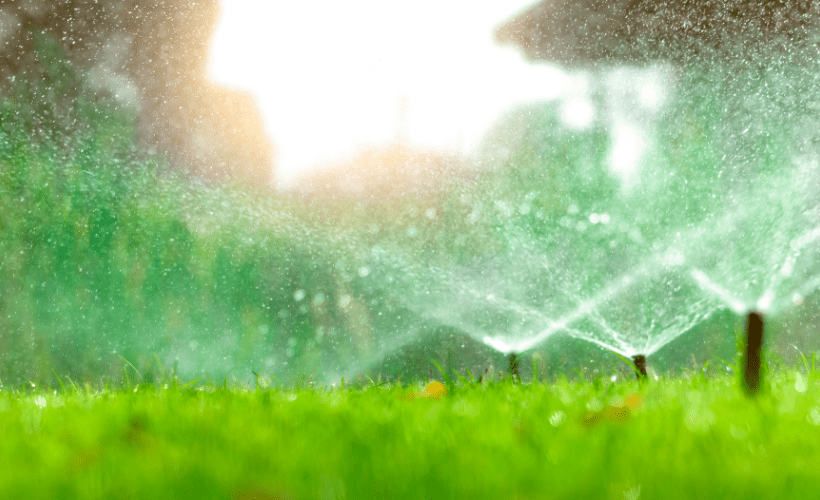A healthy lawn requires a consistent and seasonal lawn care schedule throughout the year for 2025. In Windsor-Essex County, our unique climate presents specific challenges and opportunities for lawn maintenance. This comprehensive lawn care calendar will help you keep your lawn in top condition through all four seasons.
Spring Lawn Care (March-May)
Spring marks the beginning of seasonal lawn care in Windsor-Essex. As temperatures rise and snow melts, your lawn needs attention to recover from winter and prepare for summer growth.
March: Early Spring Preparation
After a long winter, your lawn needs careful attention to spring back to life:
- Rake thoroughly to remove dead grass, leaves, and winter debris that can block sunlight and air
- Inspect for snow mold – a fungal disease common in Windsor-Essex lawns after snow cover
- Check for salt damage near driveways and walkways from winter road treatments
- Begin light mowing once grass reaches 3 inches, cutting only the top third of the blade
- Test soil pH to determine if your lawn needs lime or sulfur applications
Early detection of problem areas allows for faster recovery and prevents issues from worsening as the growing season begins.
April: Core Aeration and Over-Seeding
April is the perfect time to address soil compaction and thin areas of grass:
- Core aerate to improve oxygen flow, water absorption, and root development
- Overseed bare spots with quality grass seed suited for Windsor’s climate:
- Kentucky Bluegrass for sunny areas
- Fine Fescue for shaded spots
- Perennial Ryegrass for high-traffic areas
- Apply starter fertilizer with higher phosphorus content to encourage root development
- Begin regular mowing when grass actively grows, maintaining 2.5-3 inches height
- Sharpen mower blades for clean cuts that heal quickly and prevent disease entry
Proper spring seeding takes advantage of natural rainfall and moderate temperatures that promote germination and establishment before summer heat, for our annual seasonal lawn care schedule.
May: Weed Control and Fertilization
May brings rapid growth and the first appearance of weeds:
- Apply pre-emergent herbicide early in the month to prevent weed growth and control crabgrass and other summer annual weeds
- Spot treat broadleaf weeds like dandelions and clover before they spread
- Apply slow-release nitrogen fertilizer to support healthy growth through early summer
- Adjust mowing height upward as temperatures increase, cutting at 3-3.5 inches
- Begin monitoring for insect activity, especially European chafer beetles common in Essex County
Establishing a strong, thick lawn in spring creates natural resistance to weeds throughout the summer months.
Summer Lawn Care (June-August)
Summer in Windsor-Essex brings heat, humidity, and potential drought conditions that stress lawns. Proper care during these months focuses on green colour conservation and protection.
June: Irrigation and Pest Management
June often brings increased temperatures and the beginning of dry periods:
- Water your lawn deeply and infrequently – 1-1.5 inches once or twice weekly in early morning
- Monitor for chinch bugs and grubs, which become active as soil temperatures rise
- Apply beneficial nematodes for natural grub control if needed
- Keep mowing height at 3.5-4 inches to shade soil and reduce evaporation
- Avoid fertilizing during hot periods to prevent burning the lawn
Proper watering encourages deep root growth that helps lawns survive dry periods. Early morning watering (5-9 AM) reduces evaporation and fungal disease risk.
July: Drought Management
July is typically the hottest month in Windsor-Essex, requiring careful lawn management for our seasonal lawn care schedule:
- Follow watering restrictions if implemented by local municipalities
- Consider allowing lawns to go dormant during extreme drought – they will recover when rain returns
- Mow less frequently when growth slows due to heat stress
- Never remove more than one-third of the grass blade at once
- Keep foot traffic to a minimum on drought-stressed lawns
- Control broadleaf weeds manually rather than with herbicides during heat
Cool-season grasses common in Windsor-Essex naturally slow growth during summer heat. Dormancy (turning brown) is a natural survival mechanism, not necessarily a sign of permanent damage.
August: Recovery and Preparation
August often brings more moderate temperatures and opportunities to help lawns recover:
- Resume regular watering if reduced during July
- Apply light fertilizer application if lawns show nutrient deficiency
- Monitor for summer patch disease which appears as circular dead patches
- Begin planning for fall renovation by identifying areas needing attention
- Continue high mowing heights until temperatures consistently moderate
Late summer is ideal for evaluating lawn performance and planning fall improvement strategies.
Fall Lawn Care (September-November)
Fall is the most important season for lawn care in Windsor-Essex. The moderate temperatures and increased moisture create perfect conditions for lawn recovery and preparation for winter.
September: Major Renovation
September offers ideal conditions for significant lawn improvements:
- Core aerate compacted soil areas
- Dethatch if thatch layer exceeds 1/2 inch
- Overseeding your lawn in thin areas with cool-season grass seed varieties will help your lawn develop thickness and crowd out weed seeds
- Apply starter fertilizer to areas with new grass
- Begin gradually reducing mowing height to 2.5-3 inches
- Control perennial weeds like dandelions and plantain
Fall seeding benefits from warm soil, cool air, and typically more consistent rainfall, creating ideal germination conditions without summer heat stress.
October: Fertilization and Leaf Management
October is crucial for preparing lawns for the winter:
- Apply fall fertilizer with higher potassium to improve winter hardiness
- Continue mowing as needed, gradually lowering height to 2-2.5 inches for final cut
- Remove leaves promptly to prevent smothering grass and promoting disease
- Consider mulching light leaf coverage directly into the lawn for organic matter
- Apply broadleaf weed control for last-minute weed management
The most important fertilizer application of the year occurs in late October, storing energy in grass roots for winter survival and spring green-up.

November: Final Preparations
November focuses on final steps before winter:
- Complete final mowing at 2-2.5 inches before ground freezes
- Clean and store lawn equipment properly for winter
- Apply winter fertilizer after grass stops growing but before ground freezes
- Remove all debris, toys, and equipment from lawn areas before snow
- Plan for snow removal routes that minimize lawn damage
Proper November preparation significantly impacts how well your lawn emerges in spring.
Winter Lawn Care (December-February)
Winter in Windsor-Essex brings snow, ice, and freezing temperatures. While active lawn care decreases, some considerations remain important.
December-February: Protection and Planning
Winter lanadscaping focuses on protection for your trees and preparation for your lawn next spring:
- Minimize traffic on frozen lawns to prevent crown damage
- Avoid using salt-based ice melt near lawn edges
- Consider snow distribution when clearing driveways and walks
- Mark edges of lawns near driveways to prevent plow damage
- Review last season’s results and plan improvements for spring
- Maintain equipment – sharpen blades, change oil, replace parts
- Order seed and supplies for early spring needs
Winter provides time to research new techniques and products for the coming year, ensuring you’re prepared when spring arrives.
Year-Round Lawn Equipment Maintenance
Following a consistent lawn care schedule includes maintaining your equipment. Proper maintenance ensures reliable performance and extends the life of your lawn care tools:
- Clean equipment after each use to prevent rust and buildup
- Check and change oil in gas-powered equipment regularly
- Sharpen mower blades 2-3 times per season for clean cutting
- Replace air filters as recommended by manufacturers
- Maintain proper tire pressure on equipment with pneumatic tires
- Store equipment properly in dry, protected areas
Well-maintained equipment performs better, uses less fuel, and creates healthier cuts on grass plants.
Professional Lawn Care Services in Windsor-Essex
For homeowners without time or physical ability to maintain their lawns, professional lawn care services offer significant benefits:
- Consistent, timely applications of treatments at optimal times
- Professional-grade products often unavailable to homeowners
- Expertise in identifying and treating local lawn problems early
- Time savings allowing focus on enjoying your outdoor space
- Year-round programs tailored to Windsor-Essex conditions
Garlatti Landscaping provides seasonal lawn care programs specifically designed for local conditions and grass varieties in Windsor, LaSalle, Amherstburg, and throughout Essex County.
Call Garlatti for Scheduled Lawn Maintenance:
A beautiful lawn in Windsor-Essex requires attention throughout the year, with each season presenting unique tasks and challenges. By following this seasonal lawn care calendar and adapting to your specific conditions, you can enjoy a healthy lawn that enhances your property’s appearance and value.
For assistance with any aspect of lawn care or to inquire about our professional lawn maintenance services, Contact Garlatti Landscaping. Our 30+ years of experience in Windsor-Essex County ensures your lawn receives expert care tailored to local conditions.









Share This Article
Choose Your Platform: Facebook Twitter Google Plus Linkedin